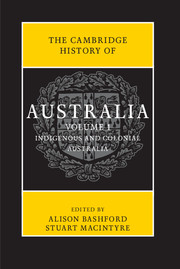Book contents
- Frontmatter
- Contents
- Abbreviations
- List of maps
- List of figures
- List of tables
- Notes on contributors
- Map
- Preface
- Introduction
- PART I
- PART II
- Further reading
- Chronology
- Index
- Frontmatter
- Contents
- Abbreviations
- List of maps
- List of figures
- List of tables
- Notes on contributors
- Map
- Preface
- Introduction
- PART I
- PART II
- Further reading
- Chronology
- Index
Introduction
Published online by Cambridge University Press: 05 November 2013
- Frontmatter
- Contents
- Abbreviations
- List of maps
- List of figures
- List of tables
- Notes on contributors
- Map
- Preface
- Introduction
- PART I
- PART II
- Further reading
- Chronology
- Index
- Frontmatter
- Contents
- Abbreviations
- List of maps
- List of figures
- List of tables
- Notes on contributors
- Map
- Preface
- Introduction
- PART I
- PART II
- Further reading
- Chronology
- Index
Summary
The Commonwealth of Australia was inaugurated on the first day of the twentieth century. Devised by elected representatives of the colonies, adopted by popular plebiscites and enacted by the imperial parliament at Westminster, this federal union created a nation-state that enjoyed exclusive possession of an island continent. It practised a system of democratic self-government that was both advanced and durable. The defining characteristics – a constitutional monarchy, a bicameral legislature elected on a common franchise, the executive responsible to the lower house, its activity restricted to federal functions – have resisted alteration. Similar constitutional arrangements persist in the six States, which have withstood repeated calls to redraw their boundaries and revise their functions. Despite the accretion of central government, the Constitution remains as it was on 1 January 1901, making Australia one of the oldest uninterrupted democracies.
The continuities extend beyond the framework of government. In 1901 there were 3.8 million Australians and they constituted 0.23 per cent of the world's population; by the end of 2012 the Australian population had risen to 22.8 million, still only 0.32 per cent of the global population. Occupying a vast landmass, the new nation used advanced methods to extract minerals and produce raw materials for the world market; mineral and energy exports still underwrite the nation's prosperity. Throughout the century the great majority of people lived not in the interior but along the coast, most of them in the south-east corner of the continent. In 1901 they enjoyed a comparatively high standard of living, with incomes that allowed most to participate in discretionary expenditure; many commentators are once again celebrating the exceptional character of Australian economic affluence and growth in a world still coming to terms with the global financial crisis (GFC) of 2007–08. In 1901 there were already high levels of literacy and advanced systems of communication.
- Type
- Chapter
- Information
- The Cambridge History of Australia , pp. 1 - 12Publisher: Cambridge University PressPrint publication year: 2013



